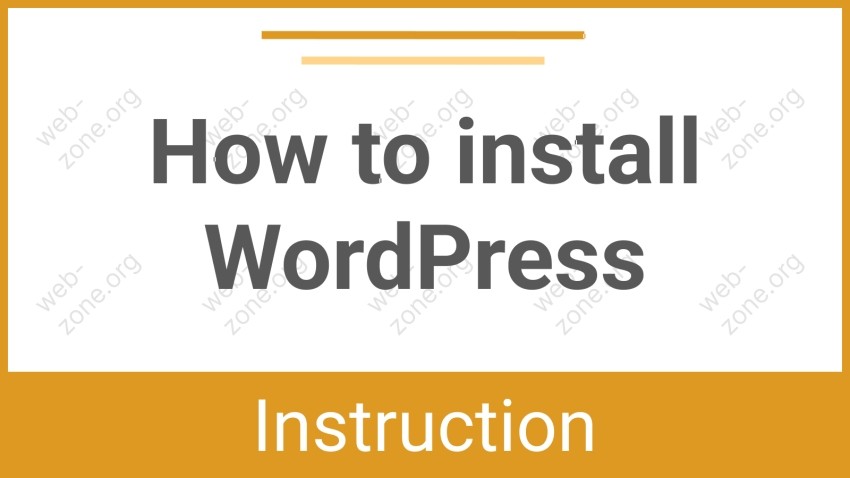
How to Install WordPress – Step-by-Step Guide
WordPress is a powerful, user-friendly content management system (CMS) that powers over 40% of websites on the internet. Whether you’re building a personal blog, a portfolio, a company website, or a full-featured online store — WordPress can handle it.
WordPress makes website creation accessible for everyone, no coding required.
What You Need Before Installing WordPress
Before you begin, make sure you have the following:
- A domain name (e.g., web-zone.org)
- A web hosting plan that supports PHP and MySQL
Minimum system requirements:
| PHP | 7.4 or higher |
| MySQL | 5.7+ (or MariaDB 10.3+) |
| Web server | Apache or Nginx |
| SSL certificate | recommended |
Three Ways to Install WordPress
You can install WordPress using different methods depending on your technical skills and project needs:
- Automatic installation via your hosting provider
- Manual installation using FTP and a database
- Local installation on your computer for testing or development
1. Quick Install via Hosting Control Panel
Most hosting companies offer one-click WordPress installation through tools like Softaculous, Installatron, or similar.
How to do it:
- Log into your hosting dashboard (usually cPanel or similar).
- Navigate to “WordPress Installer” or “Softaculous Apps Installer.”
- Click “Install” next to WordPress.
- Fill in the basic setup fields:
- Protocol (https://)
- Domain
- Admin username/password
- Site title and description
- Click Install — and in less than a minute, your site will be live!
Admin login URL:
yourdomain.com/wp-admin
2. Manual WordPress Installation (Advanced Method)
If you want full control or are running on a custom server setup, here’s how to install WordPress manually.
Step 1: Download WordPress
Go to the official website: wordpress.org/download
Step 2: Upload Files to Server
- Unzip the WordPress package.
- Use an FTP client like FileZilla or the file manager in your hosting panel.
- Upload the contents of the WordPress folder to your site’s root directory (usually public_html).
Step 3: Create a MySQL Database
- Log into your hosting control panel.
- Go to MySQL Databases and create:
- A database
- A user
- Assign user to the database with full privileges
Step 4: Run the Installer
Go to your website in a browser (e.g., yourdomain.com). WordPress will guide you through the setup process: language, admin account, site name, etc.
And also fill in the fields for the database
3. Installing WordPress Locally (For Development)
Great for developers or beginners who want to experiment without affecting a live site.
Requirements:
- Local server software like XAMPP, MAMP, or LocalWP
- The latest WordPress package
- A browser
Example with XAMPP:
- Download and install XAMPP.
- Start Apache and MySQL modules.
- Go to http://localhost/phpmyadmin and create a database.
- Extract WordPress to htdocs/wordpress.
- Visit http://localhost/wordpress to start installation.
What to Do After Installing WordPress
1. Set Pretty Permalinks
Go to Settings → Permalinks and choose “Post name” for cleaner, SEO-friendly URLs.
2. Choose a Theme
Install a multifunctional theme that will allow you to flexibly customize your site
- Airin Blog – is a Multipurpose, responsive, fast, minimal magazine theme for blogs and article sites, news and media, with many settings for all occasions.
- Bado Blog – is a cool, modern multipurpose WordPress theme with many free settings to create a responsive, fast, SEO optimized website that is easy to modify with a visual customizer.
3. Install Essential Plugins
Start with these must-have plugins:
- Wordfence Security – firewall & malware scanning
- Yoast SEO – search engine optimization
- Elementor – page builder
Common Installation Errors and Fixes
| Error | Solution |
| Database connection error | Check credentials in wp-config.php |
| White screen of death | Deactivate plugins and switch to default theme |
| 500 Internal Server Error | Reupload .htaccess, increase memory limit, or check PHP settings |
Conclusion
Installing WordPress is fast and easy, even for beginners. Whether you use one-click tools or manual setup, you’ll have a powerful, flexible platform for building the website of your dreams.
You don’t need to be a developer — you just need to get started. WordPress does the rest.











